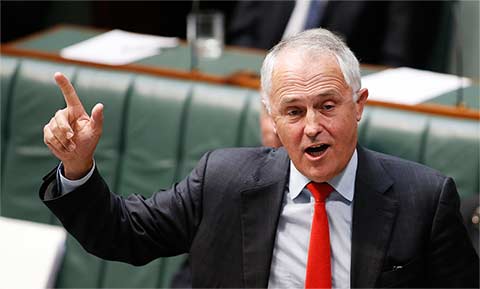The power of secret bureaucracies that can’t abide democracy
Both the TPP and data retention have been delivered by unaccountable bureaucracies that fear scrutiny and democracy.

Both the TPP and data retention have been delivered by unaccountable bureaucracies that fear scrutiny and democracy.
What happened to Malcolm Turnbull between 2012 and 2014 to transform him from an avowed opponent of data retention into the man who implemented it, from Spycatcher Malcolm to Mass Surveillance Malcolm?
Some things are obvious. All political parties that enter government discover positions adopted with confidence in opposition — like a commitment to transparency — are politically or financially problematic in government. And Turnbull, like his colleague George Brandis, who underwent a similar transmogrification from civil libertarian to fervent, if clueless, proponent of draconian laws, had to operate within the political reality of an Abbott government, with its agenda of hyping terrorism, expanding Australian military intervention in the Middle East and extending Australia’s already draconian counter-terrorism laws.
Signally, the last iteration of Tony Abbott’s barrel-bottom stunt legislation, the ineptly drafted citizenship bill, appears to have been placed on hold by Turnbull. As for data retention, however, that is scheduled to commence in full-blown mode tomorrow despite an incompetent implementation process by the Attorney-General’s Department (which helped itself to some of the inadequate funding set aside by the Abbott government for it).
In truth, though, the data retention process wasn’t led by politicians, but by national security bureaucrats, the clique of unelected and unaccountable officials who run the major security institutions in Australia — ASIO, the Australian Federal Polica, their portfolio department Attorney-General’s, and Australia’s other major security agencies, Australian Secret Intelligence Service and Australian Signals Directorate (which functions as the local office of the Five Eyes global surveillance grouping) along with a plethora of smaller agencies. These officials form a state within a state, more powerful and permanent than the passing political parade: that’s why data retention was pushed by such agencies whether Robert McClelland, Nicola Roxon, Mark Dreyfus or George Brandis was Attorney-General; failure under one was simply a prelude to a renewed effort under the next politician.
Coincidentally, as we enter a new era of Australian mass surveillance, the Trans Pacific Partnership is being debated after its finalisation last week. As has been the case all along, Australian curious to know what we have agreed to will learn more from Wikileaks, which has released the final text of the intellectual property chapter, than from their government: Andrew Robb says we can’t see the treaty yet because it has yet to be “translated”, a peculiar excuse for Australians given the existing drafts have all been in English.
In fact the TPP is the product of a similar “state within a state” process to the one that yielded data retention, but on a larger, international scale, involving trade officials and multinational corporations. The agreement is primarily the vehicle for the interests of those corporations, most of them US-based, which is why the IP chapter in effect imposes US law on another 11 countries on copyright matters. Those corporations have actually drafted large sections of the TPP text at the behest of US officials, who have acted as cyphers of US companies. Consider the numerous parallels between the processes.
The Trans-Pacific Partnership process began as a minor trade agreement between Singapore, Brunei, New Zealand and Chile before US officials took over the process at the end of the Bush administration and countries like Australia also joined. Negotiations, led by the same small group of Department of Foreign Affairs and Trade officials, have proceeded under multiple trade ministers in Australia and governments of both parties. Similarly, data retention has been driven by ASIO, AFP and AGD bureaucrats since at least 2008 (and probably earlier) under a variety of attorneys-general and both parties. Indeed, on the very eve of the commencement of the full-blown scheme, AGD still refuses to say what dataset it specifically wants service providers to retain.
The secrecy surrounding the TPP is now notorious. Even after the agreement was signed, the Department of Foreign Affairs and Trade won’t allow Australians to see the TPP text. Similarly, AGD preparations for data retention were conducted in remarkable secrecy, with industry sworn to confidentiality about consultations; companies have been threatened by bureaucrats if they reveal that they have an exemption from data retention requirements and the department refused to provide the Joint Committee on Intelligence and Security with key documents such as draft legislation, despite that committee specifically being asked to review a proposed data retention regime. Indeed, on the very eve of the commencement of the full-blown scheme, AGD still refuses to say what dataset it specifically wants service providers to retain.
Rampant use of the internet, the democratisation of communication allows unfettered ideas to radicalise people.
The IP chapter of the TPP is predicated on defining the internet as a lawless domain that must be controlled to protect the US copyright industry; the US Electronic Freedom Foundation called the TPP “one of the worst global threats to the internet”. Data retention policy similarly sees the internet as a dangerous development that has undermined the traditional power over communications enjoyed by security agencies, one that threatens to send them “dark”. And “rampant use of the internet, the democratisation of communication” allows, in the words of the former head of ASIO, “unfettered ideas and information” to radicalise people.